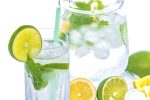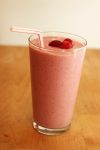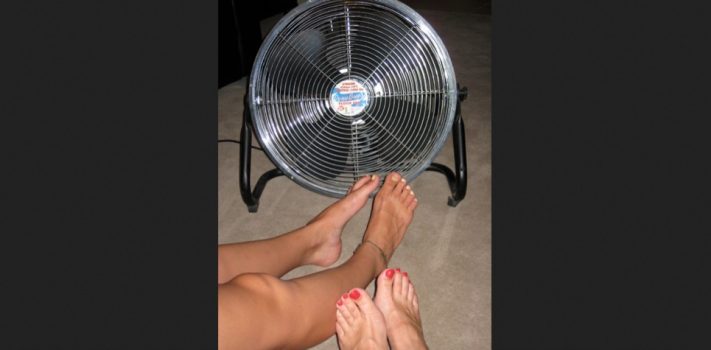(Continued from Part 1. This concludes the article.)
Ingest Cold Food and Drink
Your body has to warm everything that you ingest up to 97 degrees Fahrenheit and that uses up some of the heat in your body. Going to the store and getting ice for your cooler for a heat snap is wise preparation. It’ll keep your freezer closed and cold but give you access to chilled food and beverages for the day. Which will cool you and you will also wind up with cold water which you can use to cool yourself directly.
When we think cold food we think ice cream and popsicles and other treats. Instead, you want to plan ahead and have other frozen foods that are healthier. Frozen grapes and frozen cut-up pieces of watermelon can be eaten directly and will help cool you. Homemade yogurt-based popsicles will cool you have more nutrients than commercial treats.
Think about cold meals as well as just treats. Things like cold pasta salad, cold soups ( like gazpacho and Mul-naengmyeon), potato salad, cold cuts, bread and cheese, coleslaw, ham salad, egg salad, tuna salad, fruit salad, chilled quiche. Generally, our weather models are accurate enough to let us know a couple days ahead of a heat wave. So do your prep beforehand. Before this last heat snap, we cooked a ham. As a result, I had cold ham in the fridge so the protein for the week didn’t need to be cooked.
If you do cook inside the house, I recommend slow cookers. You can use them to slow cook meat as a poor man’s barbecue. Ribs and chicken and the like can be cooked and without an oven dumping heat into your living space. It might even be possible to have that slow cooker outside which would be even better.

 Drink a variety of beverages to hydrate. Milk, orange juice, grapefruit juice, lassis (yogurt drinks), iced teas (herbal teas as well as proper tea) and lemonade are the obvious choices. It may be worth looking into vinegar-based drinks (shrubs) these are surprisingly refreshing. Hydration can be a funny thing and sometimes a glass of milk will make me feel better than 3 glasses of water. Be careful of the powdered drinks and sports drinks. These drinks have a lot of sugar and a lot of salt. Remember the sports drinks were invented for football players doing 3-hour-long athletic practices in the Florida heat. You are probably not sweating that much or working that hard, which means your kidneys get to filter out that salt and by all accounts kidney stones are worse than the heat. If you do decide that some powdered flavored drinks should be included, I recommend the nonsport powder packets so you can have more control over the drink. When I use these, I use a pinch of salt and half the sugar the directions call for.
Drink a variety of beverages to hydrate. Milk, orange juice, grapefruit juice, lassis (yogurt drinks), iced teas (herbal teas as well as proper tea) and lemonade are the obvious choices. It may be worth looking into vinegar-based drinks (shrubs) these are surprisingly refreshing. Hydration can be a funny thing and sometimes a glass of milk will make me feel better than 3 glasses of water. Be careful of the powdered drinks and sports drinks. These drinks have a lot of sugar and a lot of salt. Remember the sports drinks were invented for football players doing 3-hour-long athletic practices in the Florida heat. You are probably not sweating that much or working that hard, which means your kidneys get to filter out that salt and by all accounts kidney stones are worse than the heat. If you do decide that some powdered flavored drinks should be included, I recommend the nonsport powder packets so you can have more control over the drink. When I use these, I use a pinch of salt and half the sugar the directions call for.
Become more nocturnal
There’s a reason that the siesta (afternoon nap) along with a longer day was a thing before air conditioning in Spain. Part of it is cultural but I argue that a large driver of that culture is dealing with heat. When I lived in the southeast, I found that it was easier to do things as it got cooler. And on the worst nights in that attic apartment we just accepted that there was going to be very little sleep and got movies to watch.
Obviously, your ability to become more nocturnal depends. In a situation where you don’t need to go to work, there’s no reason you can’t become more nocturnal (especially with LED light). If you have to get to work, you can’t become nocturnal. If you can, it helps.
Why is this better than waking up early? In my experience, you’re getting your best sleep in the early morning and interrupting that hurts you for a long time. Sleep, recovery, matters especially when your body is working harder because of the heat. So work in the tolerable (but not ideal) evening/night and let your body recover during the early morning sleep.
Cool yourself with public air conditioning
This is for when there is power but you are without air conditioning. Wherever it is that you can get public air conditioning you want to be uncomfortably chilly before you leave. That may be a public library. It may be doing leisurely shopping. It may be buying an ice cream cone with loose change at a fast food joint. Plan those cooling outings in a way that makes sense. Especially on a night we knew would be hot we would read at the public library right up until it closed so we would start off the evening cool.
If you know when your house/apartment is the most miserable try to have outings for that period or directly before that period. It’s not always possible. Regardless, when you have access to public air conditioning get yourself chilly before leaving. You want to be at the point right before you would start shivering.
Speculative Cooling Methods
This means I’ve looked into it but haven’t prototyped them myself. I found two interesting approaches: 1 from hobby pilots who use frozen vests to keep their core temperature down. 2. from NASCAR and NASA (I don’t who cribbed who) which uses cooled liquid flowing through tubes in garments to cool humans. In both cases, the humans are overheating but an air conditioning system would be too much weight and so they cool the human directly.
The first is interesting because other people have prototyped it. These approaches use the absorbent part of diapers and saturate it with a mixture of alcohol and water. This frozen slushee mixture is then sealed into the vest and you have a wearable ice pack. Or you can buy the cooling vests specifically that pilots use.
This strategy relies on having a functioning freezer (so grid power or off-grid freezer). Having frozen packs (or vests) in a freezer would help keep the freezer’s thermal mass up and provide direct cooling to you as needed. It would help get you through a temporary outage. It is also close to putting ice directly on your skin, which can damage it, so this is a higher-risk option. You have to be aware of when you have worn it too long and may be approaching skin damage. It would also not help with sleeping — that has “a bad idea” written all over it.
The second strategy circulates water through tubes that are close to your skin. A reservoir (cooler) with chilled liquid (water, maybe some chlorine mixed in, you could play with salt) and a pump send the liquid through your suit/vest and this cools you. The garments do not look complicated, it literally looks like it’s just been whipstitched to the garment. A whole system will set you back 800 bucks but a DIY version I imagine you could do for well under two hundred. The pump would be the most expensive bit followed by the fittings. The pump needs power but a battery-powered pump would be a good application.
This second system is the one I would try with high heat. It allows you to turn it on and off, even if the water is only mildly cool it will still have significant cooling effects. Ice or ice packs from your freezer can be used to drop the water temp. Heck, you could defrost dinner and cool yourself at the same time. A cheap safety vest and whipstitching the tubing to that vest would allow one system to cool the entire family in turns.
Conclusion
I hope that you have found this useful. It is at least what I would want to have learned before I was dealing with miserable heat.










